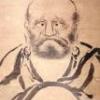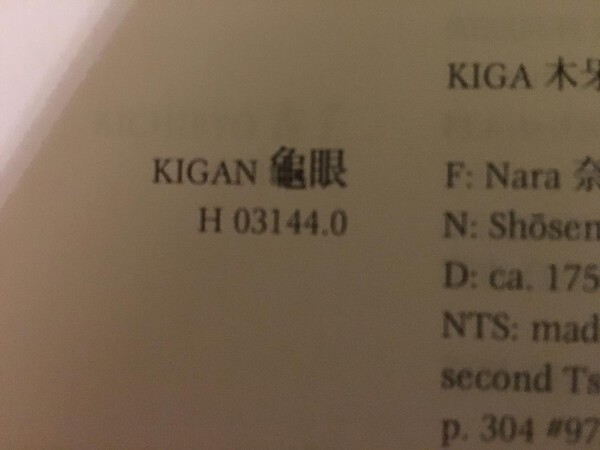-
Posts
2,745 -
Joined
-
Last visited
-
Days Won
11
Content Type
Profiles
Forums
Events
Store
Downloads
Gallery
Everything posted by Shugyosha
-
Looks like Kaga no kami to me, but there isn't a Kiyoshige with this title on Markus Sesko's list: Kaga no Kami (加賀守) Kanetaka (包高), 1st gen., Jōō (承応, 1652-1655), Sanuki Kanetaka (包高), 2nd gen., Tenna (天和, 1681-1684), Sanuki/Tosa Kinmichi (金道), Enpō (延宝, 1673-1681), Yamashiro Morimichi (盛道), Kan´ei (寛永, 1624-1644), Mino Morimichi (盛道), Jōkyō (貞享, 1684-1688), Mino Norihiro (則広), Kanbun (寛文, 1661-1673), Settsu Sadahide (貞秀), Kanbun (寛文, 1661-1673), Echizen Sadahiro (貞広), Genroku (元禄, 1688-1704), Settsu Sadanori (貞則), Kanbun (寛文, 1661-1673), Settsu Suketora (祐虎), Ansei (安政, 1854-1860), Shinano Tsunashige (綱重), 3rd gen., Genroku (元禄, 1688-1704), Ōshū Ujizane (氏真), Genroku (元禄, 1688-1704), Owari
-
Also the smith in question, for example: With modern swords that are advertised as being made by mukansa swordsmiths it's important to work out whether the sword was made before or after they were made mukansa - afterwards implies a greater level of skill. Also with Inoue Shinkai, I understand that his work after he changed his signature from Inoue Izumi Kami Kunisada is valued more highly than before the change and I remember Darcy writing something similar for Tsuda Sukehiro saying that his prime work occurred after he changed to signing his name with grass script. No doubt there are other examples of this, or perhaps where the premise works in reverse and a known event marks a drop-off in skill. Edit: my memory let me down. Here's Darcy's article that I was trying to quote: https://blog.yuhindo.com/context/#more-840
-
Fair enough - I'd overlooked that.
-
It looks ubu to me. I can't see any evidence of shortening - there's only one mekugi ana and if you look at the close-up of the nakago there's room for a habaki between the sabi giwa and the machi but nothing more, so not machi okuri.
-
Papers give it to Kyo kinko. Pretty naff though.
-
Polished ground/ surface.
-
Just realised that it's the one that Kyle Shuttleworth had for sale. Nice pick-up!
-
Hi Grev, I hope you are keeping well. 竹 - Bamboo 林 - Grove 七- seven 賢 - virtue, wisdom 直 - Nao 光 - mitsu 四 - shi 分 - bu 一 - ichi 磨 - migaki 地 - ji 色 - iro 絵 - e 毛 - ke 彫 - bori
-

Translation help on "woodblock print" much appreciated
Shugyosha replied to barnejp's topic in Translation Assistance
Hi Greg, As the print lacks the usual publishers and censors seals, is there any chance that this could be a catalogue of images to be used as a reference for artists? I had one once which had similar pictures and it rang a bell. -
Ian Chapman normally has some nice stuff and is excellent to deal with: www.nihonto.uk www.nihonto.org.uk
-
Hi Chris, It's difficult to know what to advise - my main interest is swords but I dabble in fittings so my fittings library is a bit ad hoc. If you want a book in English that deals with fittings generally, then I've found the fittings volume of Nihonto Koza by Harry Afu Watson to be a useful general reference guide but the illustrations aren't brilliant. Better from the illustrations point of view but in Japanese is Tsuba Taikan by Kawaguchi Noboro. I think beyond this it is worth acquiring more specific books on individual schools or types of fittings that you find of interest. Eventually you may find that you need something to look up fittings artists and Haynes' Index of Japanese Sword Fittings and Associated Artists is (for me anyway) the go-to - it's the equivalent of Hawleys for swordsmiths. That said, for me it's a reference and only comes down off the shelf if I need to look something up and isn't something I browse. I don't have a Meikan (book containing verified examples of artists' signatures) for fittings artists. The one by Wakayama (don't know the title off hand) is regarded as definitive and I intend to acquire this at some point. I'm sure others can chip in with some better suggestions.
-
Hi Chris and Pete, Having had another look at this - Pete is correct - the last kanji (sorry I can't copy and paste with this browser) is read as "drawn or painted by" according to Self and Hirose's "Japanese Art Signatures" so you have "Haru Aki Ho Gen Zu" - drawn (designed) by (a person whose honorary buddhist title is) Haruaki. As regards the metalworkers signature it reads "Kigan" plus kao. Haynes has a couple of artists using this "Ki" and one using this form of "Gan" but only one signing "Kigan" but using a different kanji for "Ki" (photo attached), it might be the same guy who changed his signature at some point, but I don't have any more information. As you can see, the one Haynes lists is from the Nara school and someone who knows better than me might be able to tell you whether or not the workmanship on your fuchi points in that direction.
-
Hi Chris, You're right with "Oni" or "ki" is the On pronunciation. Top right is spring Meiji - unfortunately can't do anything with the rest.
-

What's the most you spent on a sword?
Shugyosha replied to piryohae3's topic in General Nihonto Related Discussion
James, It depends on the value of the sword relative to your income and the need/ desire to remain married. I honestly don't think I will ever spend that kind of money on a sword unless my numbers come up in the lottery. That said, I hope you enjoy it and are able to share some pictures so I can indulge my voyeuristic sword fantasies. -

Why is utsuri rare on newer blades?
Shugyosha replied to piryohae3's topic in General Nihonto Related Discussion
Hi James, If I remember rightly, one of them is regarding the question you posed regarding trimming from the mune side of the blade to preserve the kissaki. Mr Nakahara's suggestion is that the shape of older tachi, where there is pronounced koshi sori but a straightening towards the tip is due to the sword being repaired in this way rather than because it was the smith's initial design or for a functional reason when the sword was made. For me, Mr Nakahara's idea makes sense as I'm of the view that in koto times form following function was the primary driver of sword design or at least in this case the need to maintain the function of an expensive item such as a sword. Thanks for starting an interesting discussion. I'll edit this to add the rider that I'm in danger here of being too definitive - it probably explains the shape of some swords. I occasionally forget that, with Nihonto, there are usually exceptions to every rule and that it is best to weigh each sword on its own merits or otherwise. -

Matchlock Certificate Translation, Please
Shugyosha replied to Bruce Pennington's topic in Translation Assistance
Hi Bruce, No it's just the basics - hinawashiki jyuhou (matchlock gun) , mumei, with dimensions: (bottom columns right to left) overall length 32.3cm, barrel length 18.9cm, calibre 0.9cm. -

Tachi Sword Tang is signed Nagamitsu - which Nagamitsu is it?
Shugyosha replied to tbonesullivan's topic in Nihonto
It's hard to get anything significant without more detailed photos (and if it has been buffed even that might not help). Here's what I can see: The patina on the tang and that the mekugi ana hasn't been drilled suggest koto. There might be a hint of koshi sori. There's something dodgy about the kissaki. -
Hi Grev, Sorry but I don't: the kanji that I can see is made of two radicals: that for moon (tsuki, getsu) on the left a comma (tomoe) on the right, so giving the "Hi" in Hishu. If you look at the part of the kanji on the right it clearly has a tail that curls around and under unlike that in Ishu. I'm sorry I know I'm not explaining this well and I can't copy the kanji over as I'm not on my normal computer and I can't find the function in this browser. Unhelpfully, "Hishu" is an alternative way of writing both Hizen and Higo provinces and refers to one of them rather than a particular region. Hida uses a different kanji than Hizen or Higo. As regards work style I'd be looking at Hizen as it doesn't look Higo style to me. Is it possible that this Mitsumasa isn't listed in Haynes?
-

I am offered to buy a sword, but I have a doubt
Shugyosha replied to antiquegallery's topic in Military Swords of Japan
Hi Artem, It doesn't look like an obvious fake from the photographs but I'd have some reservations - I cannot see a clear hamon and there isn't clear evidence of the blade being made in the traditional folded way but the tang looks well finished. The patina on the tang might put it as early as mid 19th century and this might explain the lack of clear hada as it's a feature of later swords. No signature though, so it might be a hard sell as this suggests low quality. The fittings look like they have some wear from use - loss of nunomi on the kashira etc and I don't think this would be faked and might add to the appeal for a buyer. As John says, don't pay too much for it and be confident you can move it on if it isn't for your collection. -
Hi Grev, Looks like Hishu to me so either Hizen or Higo - I'd guess Hizen as it doesn't look like Higo, but you'd know better.
-
Hi Ray, If that were mine, I'd be wrapping it in an oil-soaked cloth in the short term to try to prevent that rust from getting any worse.
-
As my kantei skills are lacking I've tried to game it to get near to the answer; here's my logic: if I remember Darcy Brockbank's research, the majority of Juyo and Tokubetsu Juyo swords are Kamakura era and the province that has the majority of high-ranked swords is Bizen. I also remember seeing something that suggested that if a sword has utsuri, most times it will be koto Bizen. Putting these things together, I'm guessing that number 3 has the greatest probability of being the Tokubetsu Juyo sword. Also, I think it is reasonable to ignore the those swords with the more "rustic" hada as they are less likely to be highly ranked and likewise any rough hada as this suggests that the overall condition isn't up to snuff. Almost certainly wrong, but it has been fun playing. Thanks for posting Uwe.
-
Hi Steven, This swordsmith was born in 1939, so you are looking at a gendai blade. From Markus Sesko: MASACHIKA (正近), Shōwa (昭和, 1926-1989), Ibaraki – “Jōshū Iwama-jū Masachika” (常州岩間住正近), real name Okashima Fukusaburō (岡島福三郎), born February 26th 1939, student of the 2nd gen. Okashima Masatada (正忠) Edit: if it's by this guy and genuine of course.



